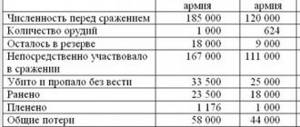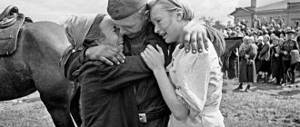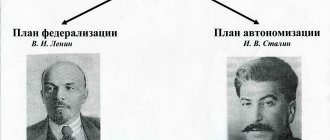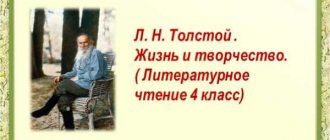With each victory over European opponents in World War II, Germany's ambitions grew. Hitler finally believed in the invincibility of his army and implemented a plan to attack the Soviet Union, but the “blitzkrieg” failed. With Hitler's attack on the USSR, the Great Patriotic War begins. Hitler developed Plan Barbarossa (Directive No. 21), a plan to take over the Soviet Union. He was counting on a quick and lightning war - a blitzkrieg. However, many grueling battles of the Great Patriotic War awaited the German invaders: the most famous of them are given in our article.
The material was prepared jointly with a teacher of the highest category
Alexandrova Ekaterina Valerievna.
Experience as a history and social studies teacher - 11 years.
Briefly about the war
Hitler himself defined this war as the “seizure of living space.” In addition, the defeat of the USSR would allow Germany to deprive Britain of a possible ally and win a final victory in World War II.
06/22/1941 Germany and allied troops invaded the USSR. For the first two years, success was on the side of the German army, but in 1943 a “radical change” occurred. Soviet troops carried out offensive operations, liberating the occupied territories. Having pushed the Germans beyond their borders, the Red Army continued its victorious raid in European cities (10 Stalinist strikes), ending it in Berlin on 02.05.
1945.
From April 29 to May 1, 1945, Soviet soldiers stormed the Reichstag. Only the third attempt was successful. The Victory Banner was installed on the roof of the building. Three times the Germans destroyed the flag with artillery shelling. Only the fourth Banner failed to be shot down.
Rice. 1. Storming of the Reichstag.
Course of events
For ease of perception, the information is collected in the table “Main events of the Great Patriotic War.”
| Dates | Battles and events | Results |
| 22.06.1941 | Germany attacked the USSR (Plan Barbarossa) | Beginning of the Great Patriotic War |
| 22-30.06.1941 | Border battles | Breakthrough of German troops |
| 29.06.1941-29.10.1944 | Battle for the Arctic (Defense of the Arctic) | The USSR retained the Northern Fleet |
| 08.09.1941-27.01.1944 | Siege of Leningrad (Operation Iskra) | Breaking the blockade 01/18/1943. Removing the blockade |
| 30.09.1941-20.04.1942 | Battle of Moscow (Operation Typhoon) | The German offensive in the Moscow direction was stopped |
| 08.01.1942-31.03.1943 | Battle of Rzhev | Elimination of the Rzhev-Vyazemsky ledge, on which the Germans were entrenched |
| 17.07.1942-02.02.1943 | Battle of Stalingrad (Uranus) | Encirclement and defeat of German troops at Stalingrad (Operation Uranus) |
| 25.07.1942-09.10.1943 | Battle for the Caucasus | Restoring USSR control over the Caucasus |
| 05.07-23.08.1943 | The Battle of Kursk (on the Kursk Bulge), as well as the largest tank battle near the village of Prokhorovka | Victory of the Soviet troops. Germany lost its strategic initiative |
| 07.08-02.10.1943 | Smolensk operation ("Suvorov") | The movement of German troops to the southwest is blocked. Smolensk recaptured |
| 13.08-22.09.1943 | Donbass operation | Liberation of the territory of the Donetsk coal basin |
| 26.08-23.12.1943 | Battle of the Dnieper (crossing of the Dnieper) | Left Bank Ukraine recaptured, Kyiv |
| 24.12.1943-17.04.1944 | Battle for Right Bank Ukraine (Dnieper-Carpathian) | The occupation of Right Bank Ukraine has been lifted |
| 08.04-12.05.1944 | Crimean operation | Liberation of Crimea |
| 10.06-09.08.1944 | Vyborg-Petrozavodsk operation | Defeat of Finland, reconquest of Karelia |
| 23.06-29.08.1944 | Belarusian operation “Bagration” | Liberation of Belarus, eastern Poland |
| 08.09-28.10.1944 | East Carpathian operation | Transcarpathia recaptured (Ukraine) |
| 14.09-24.11.1944 | Baltic operation | Liberation of Lithuania, Latvia, Estonia |
| 29.10.1944-13.02.1945 | Budapest operation | Part of Hungary, its capital, was recaptured |
| 12.01-03.02.1945 | Vistula-Oder operation | Part of Poland liberated (west of the Vistula) |
| 13.01-25.04.1945 | East Prussian operation | Reconquest of East Prussia |
| 16.03-15.04.1945 | Vienna operation | Liberation of Hungary and Austria |
| 16.04-08.05.1945 | Battle of Berlin (Berlin Operation) | Capture of Berlin (02 May), defeat of Germany |
| 06-11.05.1945 | Prague operation | Czechoslovakia liberated |
| 09.05.1945 | Germany capitulated | The end of the Great Patriotic War |
Germany did not expect such fierce resistance from the Soviet Union. Initially superior to the USSR in military experience and weapons, Hitler did not imagine that the Soviet people, driven by enthusiasm for the liberating nature of the war, would make such huge sacrifices (human losses, captivity, deprivation, hunger, destroyed cities and villages).
Rice. 2. Home front workers.
TOP 4 articles that are read along with this
- 1. Losses in World War II by country
- 2. Great Patriotic War
- 3. Beginning of the Great Patriotic War
- 4. Heroes of the Great Patriotic War
Summary of a history lesson in 9th grade “The Beginning of the Great Patriotic War”
Lesson topic:
“The beginning of the Great Patriotic War”
Lesson goal:
Study the main events - the beginning of the Great Patriotic War.
Tasks:
educational:
- To acquaint students with the course of military operations in the initial period of the war.
- The reasons for the failures of the Red Army.
- The contents of Order No. 270 of the Headquarters of the Supreme High Command dated August 16, 1941.
- The course of defensive battles near Moscow.
developing:
- To develop logical thinking in students.
- Continue to develop skills in finding cause-and-effect relationships.
- To form an idea of the main periods of the war.
- Develop skills of self- and mutual assessment.
educational:
- To cultivate in students a cognitive need, interest in the subject, and the ability to work independently.
- Continue to cultivate a sense of patriotism and respect for the historical past of your country.
Lesson type
A lesson in learning new material using the presentation “The Beginning of the Great Patriotic War.”
Forms of student work
: individual, independent, pair, frontal conversation.
Required technical equipment
: a computer with a device for sound playback, a projector at the teacher’s workplace and computers for individual work. Internet access. Textbook “History of Russia” by A.A. Danilov, L.G. Kosulina, M.Yu. Brandt, 9th grade. Conducted in a computer lab.
During the classes
I. Organizational moment. Setting the goal and objectives of the lesson.
II. Updating knowledge on the topic “The Soviet Union on the eve of the Great Patriotic War”
Conversation with the class on the following questions:
- Why negotiations between the USSR. England and France ended in failure?
— What role did the secret agreements between the USSR and Germany play?
— What lessons did the Soviet government learn from the war with Finland?
— Which countries were captured by Germany by the summer of 1941?
III. Studying a new topic.
Plan:
- On the eve of the Great Patriotic War.
- Causes and beginning of the war.
- Strengths of the parties.
- Failures of the Red Army in the summer - autumn of 1941.
- Battle for Moscow.
- Defense of Leningrad.
- Start of the project “I want to know everything!”
Problem task:
Why was the beginning so tragic?
On the eve of the Great Patriotic War.
Working with historical documents. From a telegraphic report from the “leader” from Sofia to the head of the Red Army intelligence department dated June 20, 1941, a telegraph message from “Ramsay” from Tokyo to the head of the Red Army intelligence department dated June 21, 1941.
Questions and tasks:
What plans did Germany have for the summer of 1941?
Show on the map all the states that are named in the document. (Poland, Romania, Finland, Hungary, Slovakia, Bulgaria, Germany, USSR)
Reading excerpts from the article “Intelligence on the eve of the war” about the Soviet intelligence officer Richard Sorge (“Ramsay”) - an encyclopedia for schoolchildren The Great Patriotic War.1941-1945. – M., 2012, p. 68.
Conclusion
: Reasons for the retreat of the Red Army for the first days of the war - J.V. Stalin and his entourage made mistakes in analyzing the international situation, in determining the timing of the possible outbreak of war, which led to the surprise of the enemy’s attack.
Causes and beginning of the war.
- Reasons: The state ideology of Hitler's Germany - Nazism, was war-oriented;
- Economically, Germany was the most developed country in Europe, and Hitler dreamed of world domination;
- In September 1940, Germany, Italy and Japan signed the Tripartite Pact, which provided for the division of the world; Stalin, who laid claim to the Black Sea straits, was ready to join it, but Germany also sought this. Relations between the two countries began to rapidly deteriorate.
On the morning of June 22, Moscow radio broadcast the usual Sunday programs and peaceful music. Soviet citizens learned about the start of the war only at noon, when Vyacheslav Molotov spoke on the radio. He said: “Today, at 4 o’clock in the morning, without making any claims against the Soviet Union, without declaring war, German troops attacked our country, attacked our borders in many places and bombed our cities from their planes.”
“This is not the first time our people have had to deal with an attacking, arrogant enemy,” Molotov continued. – At one time, our people responded to Napoleon’s campaign in Russia with the Patriotic War, and Napoleon was defeated and came to his collapse. The same will happen to the arrogant Hitler...” Molotov called for a “patriotic war for the Motherland, for honor, for freedom.” He concluded his speech with the famous words: “Our cause is just. The enemy will be defeated. Victory will be ours” (see slides No. 8-11).
Strengths of the parties.
Germany and Italy, Finland, Hungary, Romania, and Slovakia, which acted on its side, had 190 divisions against 170 Soviet ones. The number of opposing troops on both sides was approximately equal and amounted to a total of about 6 million people. The number of guns and mortars on both sides was approximately equal (48 thousand for Germany and its allies, 47 thousand for the USSR). In terms of the number of tanks (9.2 thousand) and aircraft (8.5 thousand), the USSR surpassed Germany and its allies (4.3 thousand tanks and 5 thousand aircraft)
Question
: Why did J.V. Stalin believe that Germany would not attack the USSR in the summer of 1941?
Conclusion
: Early on the morning of Sunday June 22, 1941, Nazi Germany and its allies unleashed an invasion force unprecedented in history on our country: 190 divisions, St. 4 thousand tanks, more than 47 thousand guns and mortars, about 5 thousand aircraft, up to 200 ships. In the decisive directions of its offensive, the aggressor had many times superiority in forces. The Great Patriotic War of the Soviet Union against the Nazi invaders began. It lasted 1418 days and nights.
Failures of the Red Army in the summer and autumn of 1941.
On June 22, German Colonel General F. Halder wrote in his office diary: “The offensive of our troops came as a complete surprise to the enemy. The units were taken by surprise in a barracks arrangement, the planes stood at the airfields, covered with tarpaulins, and the advanced units, suddenly attacked by our troops, asked the command about what to do” (viewing the chronicle).
Factors that complicated and hampered the organization of the country’s defense:
- firstly, Germany transferred its economy to the production of the latest military equipment much earlier than the Soviet Union, in addition, it seized the weapons of more than 200 divisions of the defeated or capitulated armies of the capitalist countries of Europe. In France alone, the aggressor captured 4,930 tanks and armored personnel carriers, 3 thousand aircraft;
- secondly, unjustified repressions against the leadership of the Armed Forces, the national economy and the military economy significantly weakened efforts aimed at strengthening the country's defense and led to personnel confusion, especially in the highest echelon of military leadership;
- thirdly, gross miscalculations of our political and military leadership in the combat training of troops, determining the timing of the start of fascist aggression and the direction of the enemy’s main attack, underestimating his forces and overestimating the capabilities of his troops;
- fourthly, the lack of the necessary combat experience among the command and rank and file of the Soviet Armed Forces, their focus on a rapid counter-offensive and victory with “little bloodshed.”
The territory of the USSR occupied by the enemy soon exceeded 1.5 million km. Before the war, 74.5 million people lived there. The number of Soviet citizens who died in battle, who were captured in Hitler's concentration camps, reached several million by the end of autumn 1941. This was explained not only by the enemy’s superiority in forces and means of armed struggle. The Red Army still did not have sufficient experience in waging war on such a scale, in organizing the interaction of military branches, or in the most effective use of military equipment. The Supreme Command Headquarters, the front command, military leaders and commanders of various levels learned the art of warfare in an extremely difficult situation, making serious mistakes under these conditions.
At the beginning of October 1941, the strategic front on the main, Moscow direction was broken through. Five Soviet armies were surrounded in the Vyazma area. On October 20, Moscow and the surrounding areas were declared under a state of siege. The situation reached a critical point when the enemy crossed the Moscow-Volga canal and partially broke through to Khimki. (View the chronicle “Offensive of German troops”, see slide No. 9).
Question
: What do you see as the reasons for the failures of the Red Army during the first months of the war?
Conclusion
: As a result of the unfavorable outcome of the border battles for the Soviet Union, fascist German troops quickly advanced 400–500 km in the northwestern direction, 450–600 km in the western direction, 300–350 km in the southwestern direction, and captured the territory of Latvia, Lithuania, part of Estonia, Ukraine, almost all of Belarus and Moldova, invaded the territory of the RSFSR, reached the distant approaches to Leningrad, and threatened Smolensk and Kyiv. A mortal danger looms over the country.
Battle for Moscow.
When planning the so-called “Blitzkrieg,” the Nazi leadership hoped to immediately break through Smolensk to the Soviet capital and capture it before winter. However, the troops of the Red Army thwarted his plan in the summer defensive battles. Despite this, the Nazi command did not abandon its intention. On September 6, it again decides to capture Moscow. It seemed to the Nazis that with the completion of the task, the ultimate goal of the Blitzkrieg would be achieved - the defeat of the Soviet Union. On September 30, 1941, the general German offensive against Moscow began.
The Nazis' general offensive against Moscow began on September 30 with an attack by the 2nd Tank Group on the troops of the Bryansk Front in the Shostka area. On October 2, the main forces of Army Group Center attacked the positions of the Western Front and Reserve Front. Heavy fighting ensued. Soviet troops steadfastly repelled enemy attacks. However, the weakness of their defensive positions and multiple superiority in manpower and equipment allowed him to wedge into the defense line of our troops on the very first day of the offensive.
The Central Committee of the Party and the State Defense Committee in these extremely alarming days saw its task as defending the capital at any cost and quickly mobilizing the forces of the people and the country’s resources for its defense. On October 5, the State Defense Committee adopted a special resolution on measures to protect Moscow. The Mozhaisk line of defense was determined to be the main line of the Western Front troops. On October 6, the Headquarters gave directives to bring this sector into combat readiness and allocate for this purpose from its reserve 6 rifle divisions, 6 tank brigades, more than 10 anti-tank artillery regiments and machine-gun battalions. Several divisions of the Northwestern and Southwestern Fronts and part of the forces of the right wing of the Western Front were also hastily transferred here. In total, within a week, 14 rifle divisions, 16 tank brigades, more than 40 artillery regiments and a number of other units were brought up to the Mozhaisk line. But these formations were not fully staffed, and their total number did not exceed 90 thousand people. (see slides no. 30-32).
By December 1941, the general situation on the North German front had changed. The Red Army stopped the enemy's advance along the entire front and launched offensive operations on the flanks.
Despite the fact that the enemy still had a numerical superiority in men and military equipment, the initiative in conducting combat operations began to pass to the Soviet Armed Forces. The first victories near Moscow, Tikhvin and Rostov further strengthened the morale of Soviet soldiers. The conditions are ripe for launching a counteroffensive on the main, western, direction. It was supposed to play a big role in solving the most important tasks - to wrest the strategic initiative from the enemy, to change the course of the war in its favor.
During the first days of the counteroffensive, Soviet troops, inflicting strong blows on the enemy, liberated several large populated areas. Hitler demanded that Army Group Center hold areas that were of important operational and military-economic importance. The fascist German command, having replenished the troops with people and weapons, tried in every possible way to repel the counter-offensive of the Red Army. However, this was not destined to come true (see map, slide No. 34).
After the war, fascist generals were reluctantly forced to admit that the attacks of Soviet troops near Moscow almost led their army to disaster. General Westphal, for example, stated that “the German army, previously considered invincible, was on the verge of destruction.”
During the offensive operations, Soviet troops liberated over 11 thousand settlements from invaders, including the cities of Kalinin and Kaluga, and eliminated the danger of encirclement of Tula. The enemy was driven back 100-250 km from Moscow. the immediate threat to the capital and the entire Moscow industrial region disappeared.
Question
: What do you think was the significance of the victory of the Red Army near Moscow for the further course of the war?
Conclusion
: The victory of Soviet troops near Moscow was of great importance in the fight against fascism. Hitler's Germany, which enslaved dozens of European nations, suffered a serious defeat for the first time in World War II. At the walls of the Soviet capital, the myth of the “invincibility” of the Wehrmacht was dispelled. The victory near Moscow marked the beginning of a radical turn in the Great Patriotic War.
Defense of Leningrad.
In August, German troops launched a powerful attack on Leningrad. On August 30, 1941, the city found itself “in the pincers” of encirclement. The German-German Army Group North sought to break through to Leningrad. In fierce battles near Luga, south of Lake Ilmen, near Staraya Russa, and in the Krasnogvardeysk region, Soviet troops exhausted the enemy with defense and counterattacks and inflicted significant losses on him. However, the enemy managed to occupy Estonia and break through to the immediate approaches to Leningrad. Here the enemy met the insurmountable defense of Soviet troops and the working people of Leningrad who rose to defend their city.
Under the leadership of the Military Council of the Leningrad Front, party and Soviet organizations of Leningrad and the region around the city, a system of defensive structures was created, a people's militia was formed, and partisan detachments were formed behind enemy lines. On September 8, fascist German troops managed to break through to Lake Ladoga, capture Shlisselburg (Petrofortress) and cut off land communications connecting Leningrad with the country. The enemy tried to take the city by storm, but was repulsed and stopped at the near southwestern and southern approaches to it. The heroic epic of the struggle of the army, the working people of Leningrad, and the navy began in the most difficult conditions of the blockade, which lasted almost 900 days and went down in history as an unsurpassed example of military and civil valor, resilience and mass heroism of the Soviet people (newsreel - see slide No. 42).
Bloody battles were already taking place on the southern outskirts of Leningrad, on the Pulkovo Heights. After several unsuccessful offensive attempts, Hitler chose to change tactics. He said, “This city must be starved. Cut all supply routes so that mice cannot get through. Bomb mercilessly from the air, and then the city will collapse like an overripe fruit.”
Constant bombing of the city began. Besieged Leningrad found itself with almost no food supplies. Bread was now delivered only by air and ice road across Lake Ladoga.
According to official Soviet data, about 642 thousand people died from starvation during the blockade. According to other estimates - up to 850 thousand (see slide No. 45-47).
Question
: Why do you think the Germans never managed to capture Leningrad?
Conclusion
: On January 27, 1944, the blockade of the city was finally broken. By this time, 560 thousand residents remained in the city - five times less than at the beginning of the blockade. The siege of Leningrad lasted 880 days and became the bloodiest blockade in human history.
Start of the project “I want to know everything!” presentation – about G.K. Zhukov.
IV. Reinforcing the material learned in the lesson.
Work to solve a problem task.
- 1 group. For the first time in months, German troops inflicted a series of major defeats on Soviet troops. Select and attach reasons with magnets.
- 2nd group. Select and attach to the board everything that influenced the rapid advance of the German armies deep into the territory of the USSR.
- 3rd group. The heroic resistance of which cities thwarted Hitler's plan for a lightning war?
Select sheets of city names and attach them to the board.
- 4th group. Place the events of 1941 on the board in chronological order.
V. Summing up the lesson.
Homework.
- Paragraph No. 29.
- Write down and memorize the main dates of the beginning of the Great Patriotic War.
Application
.







